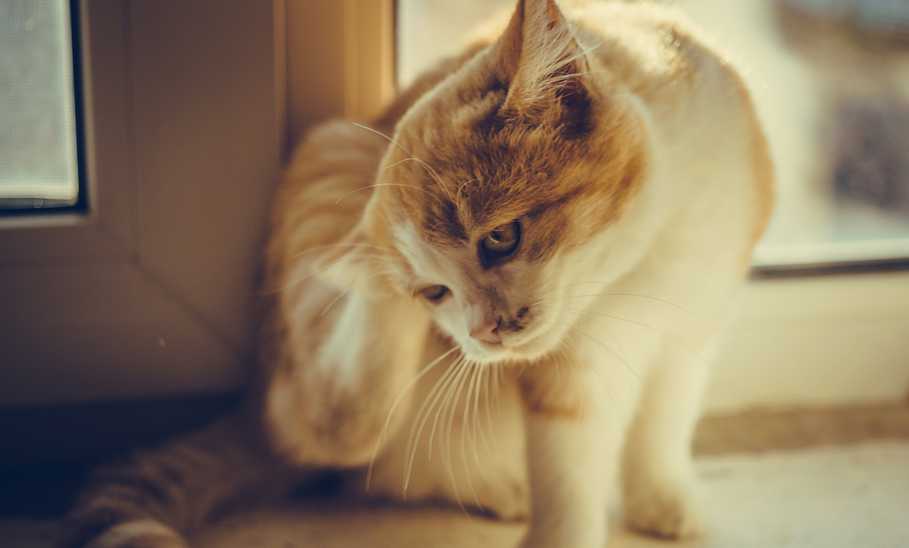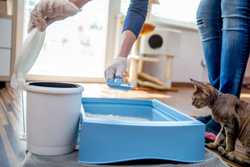How to Tell If Your Cat Has Fleas and What to Do About Them


Our evaluations and opinions are not influenced by our advertising relationships, but we may earn a commission from our partners’ links. This content is created by TIME Stamped, under TIME’s direction and produced in accordance with TIME’s editorial guidelines and overseen by TIME’s editorial staff. Learn more about it.
Out of over 300 species of fleas in the United States, Ctenocephalides felis, or the cat flea, is the one that prefers cats. And in North America, this is the most common flea affecting domestic dogs. Read on to learn more about fleas and the signs that your cat could have them.
The cat flea is a wingless insect that, despite the name, affects cats, dogs, birds, and over 130 wild mammal species across all continents except Antarctica. Fleas are blood feeders and pierce skin with serrated blade-like mouthparts, then insert a straw-like part to drink. Because of the energy demands of egg laying, female fleas ingest more blood than males.
Fleas are reddish-brown and about 2 to 4 mm long. They’re oval-shaped, but thin and flat, which makes it easy for them to move quickly through animal fur and escape detection. If your cat has fleas, you might not see them even when you part your pet’s fur to look for them.
Not all cats will have extreme itchiness from fleas, but if a cat has developed an allergy to proteins in flea saliva (called Flea Allergy Dermatitis or FAD), even just one flea feeding on them can cause intense scratching, licking, and/or biting at their skin along their back, hind legs, back of the neck, base of the tail, and the belly—especially between the hind legs.
As a result of FAD, a cat can develop sores, scabs, and fur loss from excessive grooming and scratching. You might see redness, scabs, and/or fur loss, particularly along the back.
Because the itching can be constant, your cat may appear restless or agitated.
Since cats are fastidious groomers, they’re bound to ingest a flea or few while cleaning themselves. If they ingest a flea that’s carrying the immature (larval) stage of the tapeworm Dipylidium caninum, the cat will become infected and the tapeworm will grow to maturity in the cat’s small intestine. A few weeks after becoming infected, a cat will shed sections of the tapeworm called proglottids. These look like grains of rice and may be observed on a cat’s anal area or on their stool. Just because you don’t see proglottids doesn’t mean your cat doesn’t have tapeworms.
Flea droppings are called flea dirt. Often, you’ll see these small, black specks on a cat’s skin instead of the fleas themselves. If you suspect your cat has fleas, part their fur and look for flea dirt.
You might also find flea dirt elsewhere, such as on your cat’s bed — and yours if your cat sleeps with you. If you’re unsure what you’ve found is flea dirt, put some on a paper towel and add water. If it turns red, it’s flea dirt.
Fleas are small, thin, and fast, so when you part your cat’s fur and start searching for them, you may or may not see them. This is true for the environment too, and there, you may only see 5 to 10% of them. To have greater success finding fleas on your pet, use a flea comb, which has teeth set closer together than regular combs.
A flea comb will pick up fleas, flea dirt, and eggs (though you aren’t likely to see eggs because they’re so small—about 0.5 mm). However, a flea comb won’t eradicate a flea infestation because flea eggs and the two immature stages—larval and pupal—are in the environment and not on your pet. When using a flea comb, be mindful if your cat’s skin is red and irritated, because passing a flea comb over scabs or sores will be painful. Keep a bowl of warm soap water nearby and dunk the comb in it every few strokes to remove debris and drown fleas.
Cats can get fleas from other animals—wild or domestic—including stray cats, your dog, or other people’s pets they encounter. They can also pick up fleas from the environment where any flea-infested pets or other wildlife have been.
Fleas can also come into your home on their own through windows or doors. If you moved into an apartment or home, fleas could potentially already be there in places such as the carpet or yard. In fact, the vibration of walking on carpet, or vacuuming carpet, will cause flea eggs to hatch. Even bringing in flea-infested used furniture or carpet can introduce fleas to your home.
If your cat is clearly uncomfortable—scratching a lot, excessive licking, and/or biting at their skin—take them to a veterinarian. You should also schedule an appointment if you see any of the following: fleas, flea dirt, fur loss, irritated/red skin, sores, scabs, tapeworm segments around the anus, or any other abnormal appearance to your cat’s skin or fur. Fleas are not easy to get rid of, so it’s ideal to get veterinary help. If you have pet insurance or you signed up for a pet wellness plan at your veterinary clinic, check to see if flea products are covered.
If your cat is a kitten, they absolutely should see a veterinarian because compared to an adult cat, they’re more prone to becoming anemic from fleas. And, some products are unsafe to use on kittens until they reach a certain age.
Fleas can also carry a bacterium known as Bartonella, which can be transmitted to cats while a flea is feeding on them. Cats often won’t have clinical signs from a Bartonella infection but some might develop a fever, enlarged lymph nodes, and other symptoms. Bartonella can also affect people if a person gets a cat scratch and flea dirt (that was on the cat’s nails) gets into the wound.
Mycoplasma is another bacterial blood infection cat’s can get from infected fleas, but it’s less common. Cats may not develop any symptoms, or they can develop non-specific signs like weakness, fever, and weight loss. Some cats with Mycoplasma can develop severe anemia.
Flea treatment for cats include products that are pills, collars, shampoos, and spot-ons. Some treatments are prescription and double as a preventative for other parasites, while some are over-the-counter. Your veterinarian is the best person to advise which products(s) to use, as some may not be safe depending on your cat’s age (e.g. kitten) or health status, such as if they’re pregnant or nursing.
You can’t treat your pet and not the environment — both are required to resolve the problem. Treat your cat(s) and dog(s) at the same time you treat the environment; if not the same day, then at least within one day of each other.
Environmental treatment includes:
Detailed instructions on how to get rid of fleas in your environment can be found in my guide.
It’s important that cats and dogs stay on year-round flea prevention because fleas aren’t just summer creatures. They’re out in the cold, as well. Fleas can survive for 10 to 20 days when temperatures are between 33 and 46 degrees Fahrenheit. Even if there’s a long freeze, fleas aren’t just outside. They can be inside too, where it’s warm. Your indoor environment (and even the warmer dens and burrows of wildlife) can be a great place for fleas to have a cozy winter on the couch by the fireplace. And since it can take months of diligent laundering and vacuuming to rid a home of fleas, keeping pets on prevention through the winter is a small price to pay in comparison.
It’s ideal to take your cat to a veterinarian for an exam (and essential if your pet is a kitten) because your cat might also have other issues due to fleas, such as a skin infection, tapeworms, anemia, etc. If you have dogs, they will also need to be treated for fleas. If needed, look for a low-cost clinic or get a free exam at a VCA hospital if you’re a new client.
Bathing your cat in warm soapy water is a good way to kill adult fleas on them, though it’s not a preventative and will never clear up a flea infestation in a home because other stages of the flea’s life cycle don’t occur on your pet. In the off chance your cat is amenable to a bath, you can use a mild soap like classic Dawn dish soap. However, I don’t recommend using Dawn repeatedly because it can be drying.
If you use flea shampoo, it needs to be a cat product and you need to read the fine print to make sure it’s safe for your cat’s age, particularly if they’re under 12 weeks old. Never use dog-only flea shampoos or spot-on products as they are toxic to cats and can have serious side effects including death. Flea shampoo alone won’t resolve an infestation because it isn't a preventative and it doesn't address the flea stages that occur in the environment.
To get rid of fleas indoors, all cats and dogs must be treated with an appropriate flea product and you’ll need to treat your indoor environment (and outdoor, if applicable)—all within 24 hours of each other. You can ask your veterinarian what over-the-counter topical flea product they recommend for your pet and which one’s you should steer clear of. As discussed earlier, staying on a flea preventative year round is essential to keeping fleas at bay.
The information presented here is created by TIME Stamped and overseen by TIME editorial staff. To learn more, see our About Us page.



